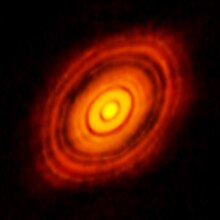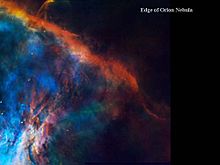Protoplanetary disk


A protoplanetary disk is a circumstellar disk of material around a young star, usually of the T Tauri type. They are sometimes also known by the abbreviation proplyds as the physical processes that lead to the formation of planets occur in these disks. Protoplanetary disks are accretion disks around young stars that are essential for understanding the formation of the star and a possible planetary system.
Observation
The disks are directly observable as nebulous material at certain wavelengths or as an excess in the infrared emission of the central star. Its size is usually several hundred astronomical units and can reach radii of up to 1000 AU. Their central regions may be at high temperatures heated by the central star and accretion processes. Younger protoplanetary disks are often accompanied by polar jets through which some of the material escapes and flows towards the central star.
Training

Disks form in the same star formation process that produces the central star. A protostar is formed by the condensation of material from a molecular cloud composed mainly of molecular hydrogen fragmented by its own gravity upon reaching critical conditions of size, mass or density. In the collapse, the fragmented cloud contracts, gaining density and forming a protostar in its center. However, the outer material, forced to conserve the angular momentum of the system, does not fall directly on the central body but is supported by the centripetal force associated with its rotation. The rotation causes the outer material to fall onto an extended disk-shaped region perpendicular to the system's axis of rotation. Typical collapse times are about 100,000 years and the disks formed can persist for 1-10 million years. The disk material is slowly accreted by the central star while the outer material slowly diffuses to greater distances while conserving angular momentum. The oldest protoplanetary disk discovered so far could be 25 million years old.
Secondary circumstellar disks

Planetary systems are formed in protoplanetary disks. The cold outer material condenses into ice grains that can interact with each other, aggregating and forming progressively larger bodies until they acquire enough mass to gravitationally influence the orbits of other nearby bodies. These bodies are called planetesimals. In the internal regions of the stellar system, temperatures are high enough to prevent ice condensation, but the same processes act on refractory materials with much higher evaporation temperatures. Collisions between planetesimals can be destructive or produce even larger bodies to form protoplanets. However, destructive collisions produce large amounts of dust that surrounds the central star in a secondary disk absent of gas and which can persist for several hundred million years.
Contenido relacionado
Non-Aligned Movement
Template:Portals
Tacna Province